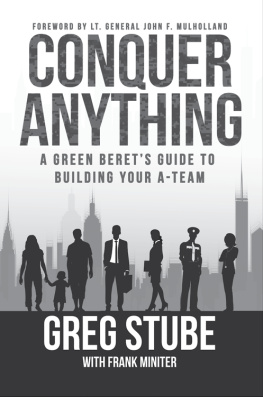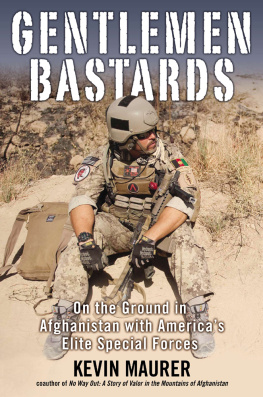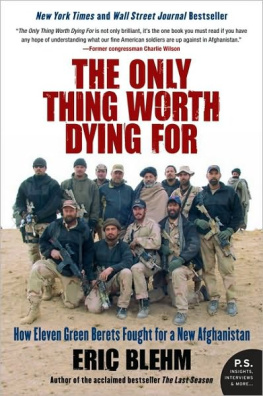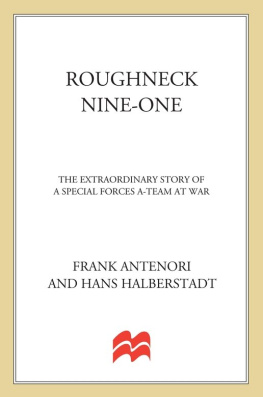I chose for this book to be released in May because
I want to dedicate it to the real fabric of America,
to every mother back in Fort Living Room
who is behind every man and woman who served
or is serving this great nation.
HOW TO BUILD YOUR A-TEAM
Diversity Is Only Strong When the Differently Shaped Parts Fit Together as a Puzzle
We are what we pretend to be, so we must be careful
about what we pretend to be.
KURT VONNEGUT
M aybe you are into sports and remember how the Boston Red Sox came back in the 2004 American League Championship series to become a team no one could beat after being down three games to none in the seven-game series against the Yankees. Or maybe you think of the Chicago Bulls in the 19951996 season with Michael Jordan at his best with Dennis Rodman, Randy Brown, and more. What you are thinking of are likely the stars and the coaches, sure, but beyond even them is a team that suddenly plays like a team, as if each player fits seamlessly with his or her teammates. How do you recruit and develop a team of individuals, maybe of exceptional individuals, into one tight unit moving down the battlefield, field of play, or business sector expertly?
Common perception is that the best or winning team is simply a collection of the best players. In the Green Berets, I have learned thats not true. It is common to see talents not fully utilized on a team. Its also common in the workplace to see the best subject-matter expert in a leadership role even though they dont have the skills to lead. Leadership and operation knowledge are entirely different things, with challenges inherent to both roles that have nothing to do with actual tasks at hand. Anyone whos ever had a boss who isnt good with people knows what I mean already. Someone might be a great welder or a great accountant, but they arent necessarily the right person to manage operations or lead the team. They might actually be the best in the world at what they doyet still shouldnt be a team leader.
In the Green Berets, I was part of a method for building teams that had been honed to a razors edge. When I think about this I recall some Green Beret A-Teams I served on. Actually, I see the Green Beret A-Teams I served differently in hindsight. At the time, I was so deep into the details, into the Green Beret method Ill tell you about here, that I was also missing the big picture that can help you in your private life and career.
Of course, we did some things together I cant tell you about, but its the method that were after, not the particulars of any mission.
First, let me warn you, how the Green Berets build a teamand how start-up businesses flourish and how small-budget sports teams can surprise everyone by winning championshipscan seem counterintuitive, even as if they are exceptions. But in my experience, these are not anomalies. They are teams that broke the norms to get something right. The keys to putting together a team to accomplish a goal begins first with the fundamentals we already talked abouthaving a code, a defined missionbut at this stage picking or recruiting an A-Team has more to do with breaking free from political correctness, from bias, and even from things youve been taught so you can see what makes every part (every team member) valuable or problematic. This doesnt just have to do with individual prowess, but also with how these parts fit together.
Now, the methodology behind picking the right team has been dramatized in movies like the 1967 film The Dirty Dozen , starring Lee Marvin, and even by the 1980s television show The A-Team , which was supposed to be about a rogue team of Green Berets working to do good as they tried to clear their names. Perhaps the best sequence of scenes showing the recruitment of a diverse and incredible team was done by writer and director Akira Kurosawa in his 1954 epic The Seven Samurai . Those examples, however, show but dont tell. Heres the real, intricate process for recruiting a team that doesnt just look good on paper, but that can achieve the objective.
If you are worried that the Green Beret method Im explaining here might not be relevant to the team you are building to succeed in business or life, dont be. There are more parallels than exceptions. And many business leaders have nodded along as Ive related my insights to them before telling me Id got to the heart of what they have often found and try to say.
Chris Zarpas, who, as vice president of production and acquisitions at the Walt Disney Company, developed and supervised numerous motion pictures including Beaches starring Bette Midler, and later, as co-president of Island Pictures in Los Angeles, produced Toy Soldiers for Tri Star, Strictly Business for Warner Bros. and Sandlot for Fox, had this to say:
We all take flying for granted. But when you think about it, a commercial jet liner is 100 tons of sheet metal and wire. That it can somehow fly through the air, transporting 150 people from NY to Paris seems impossible. Its awe inspiring.
A movie is very similar. It starts as only 120 8.511 pieces of paper. And then 250 people (the crew) who have never met one another, assemble together at some distant location and 69 months later, a great movie results. The team is hand-picked and led by the producer according to a variety of variables, such as the relative stature and experience of the director, budget size, genre, etc. There are many military parallels.
The Green Beret Method
I have been a part of many efforts to select the perfect A-Team for certain missions. By the time a team is selected to perform highly specified tasks a long, persistent, and redundant assessment and selection process has been utilized in order to build the right teams to choose from.
In the Special Forces (SF) it is understood that assessment never ends. We say this because any SF career begins with the assessment and selection course Define Assessment. All candidates are assessed, but few are selected. The assessment and selection process goes on in perpetuity because having a minimum qualification to become a Green Beret to start with doesnt mean that any team member is best suited for any given mission. It also does not count for so many changes that people go through. A persons current disposition matters too.
Our Special Operations units are the best in the world partly because of constant reassessment. It is not enough to say that you accomplished something in the past and so deserve to be on the next team. What you did before doesnt necessarily qualify you for whats to come. A persons posture, attitude, and motivation change. This goes for Green Berets too. Among the best, there are still better and lesser picks. It is not disrespectful to anyone to make the most appropriate selection we can. By all means we need to use tact, but we still need to sort people out for success.
Our objectives in life and business vary. Whether we are choosing someone to be a business partner or an employee, questions need to be answered to satisfy the objectives and requirements at hand. We hope the people in the positions last as well, as we are investing in them.
So we start with honest questions. Who would you select as a work partner? Would that be the same person youd pick to care for your ailing mother? Who would you select to help you with a marketing plan? Would they also be best to provide physical security for you or your property? The variables are infinite. What makes it even harder is that our choices among available people are few in most cases. That is an advantage the military has; they have a bunch of people who are qualified for the tasks at hand. The people are trained and somewhat vetted already. This is something I miss about life in the military, but what I learned there helps me greatly now that Im a civilian.
In the Special Forces, our membership was based on working and training hard. We did this in order to remain in contention for the biggest missions that might come down. Pick me! Pick me! Those words werent spoken as such, but that was the overall feeling and motivation. Each A-Team works very hard on fundamental skills and physical fitness in order to gain maximum consideration when the nation needs something dangerous done. So the teams are in competition with one another. Some businesses have set up new product-development departments like thiswith competing teams all trying to get chosen.
Next page








